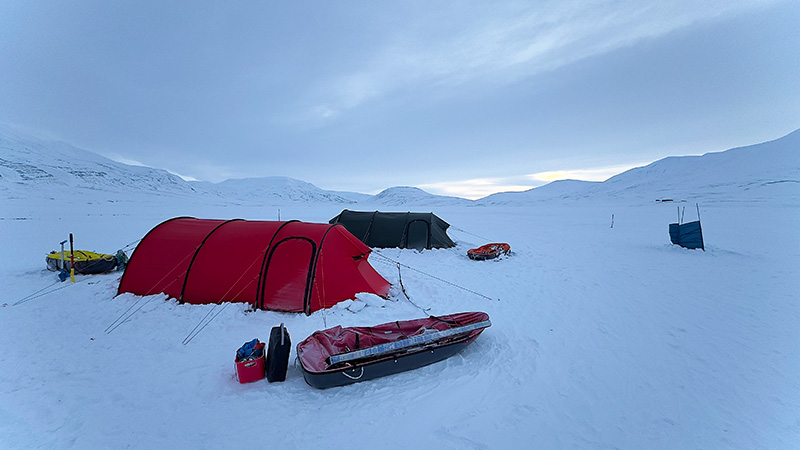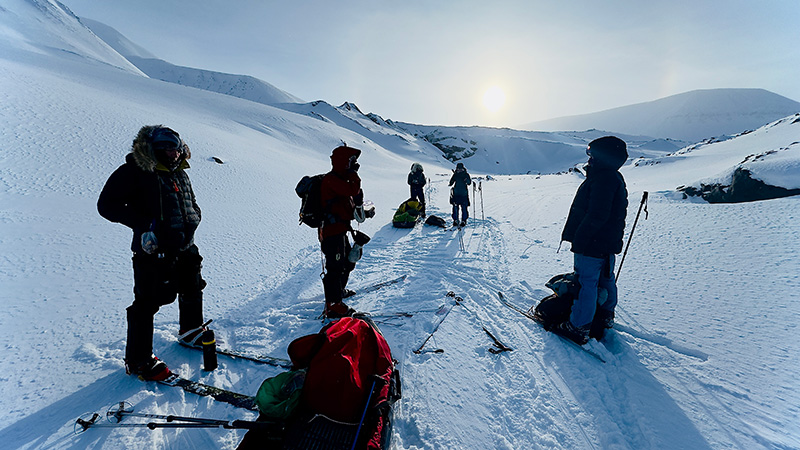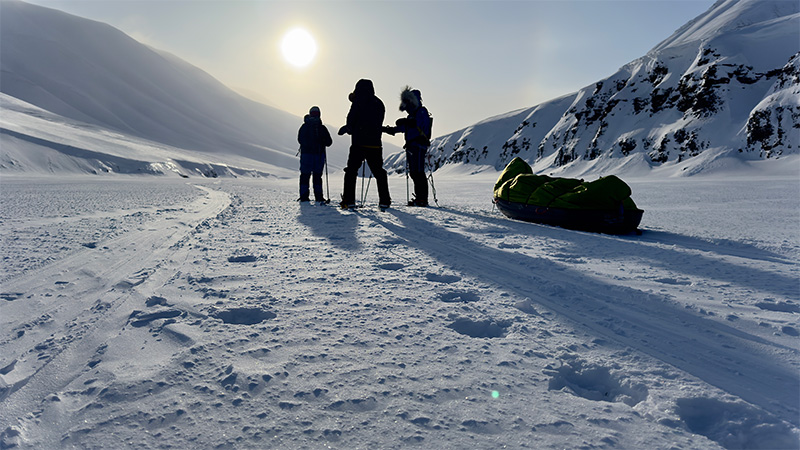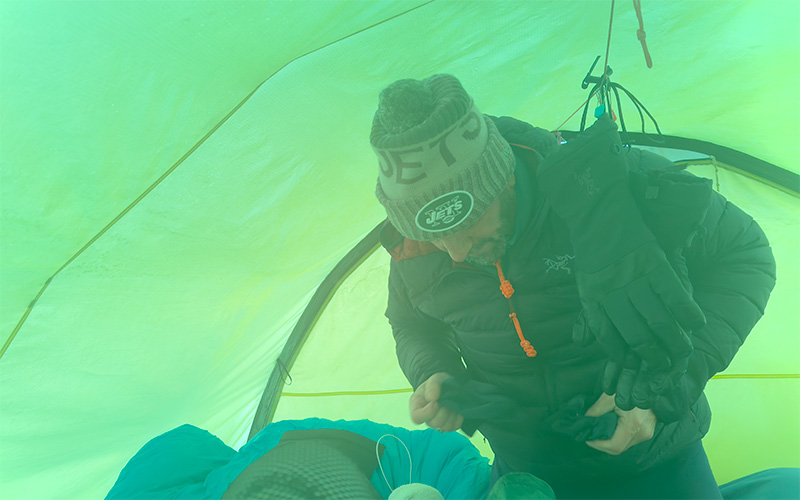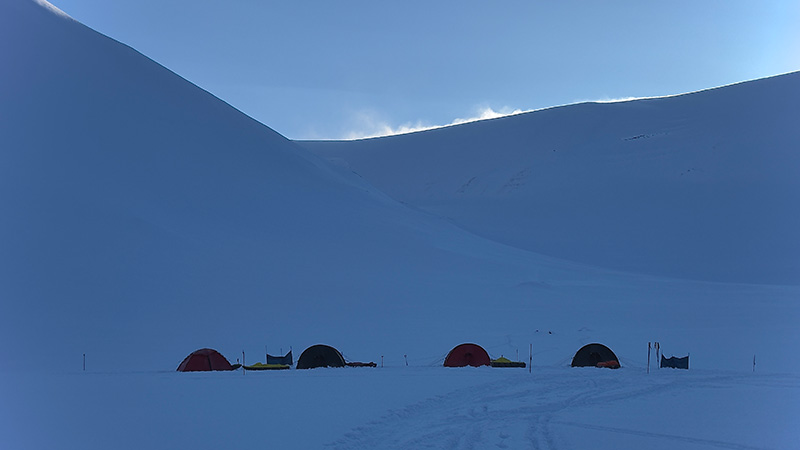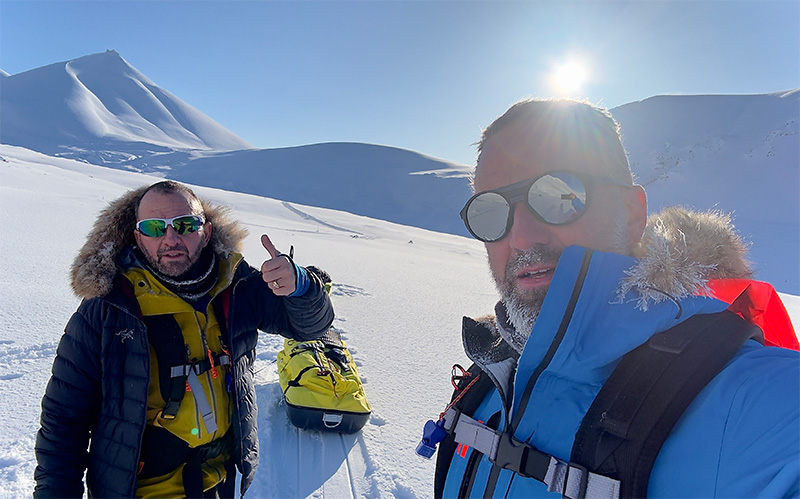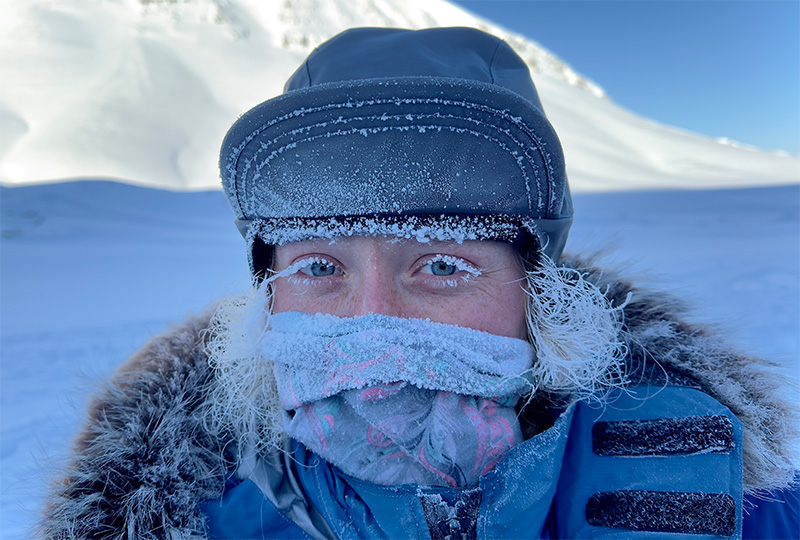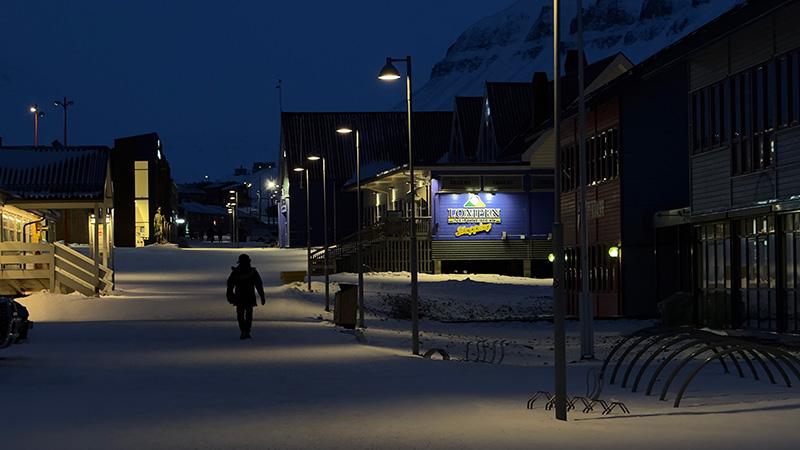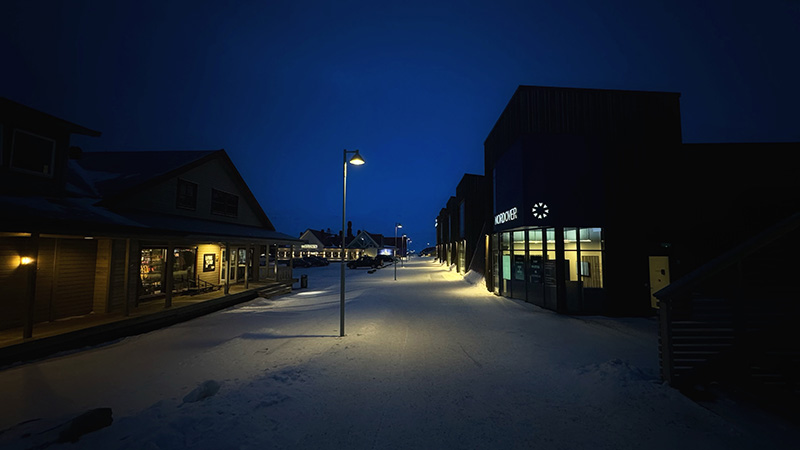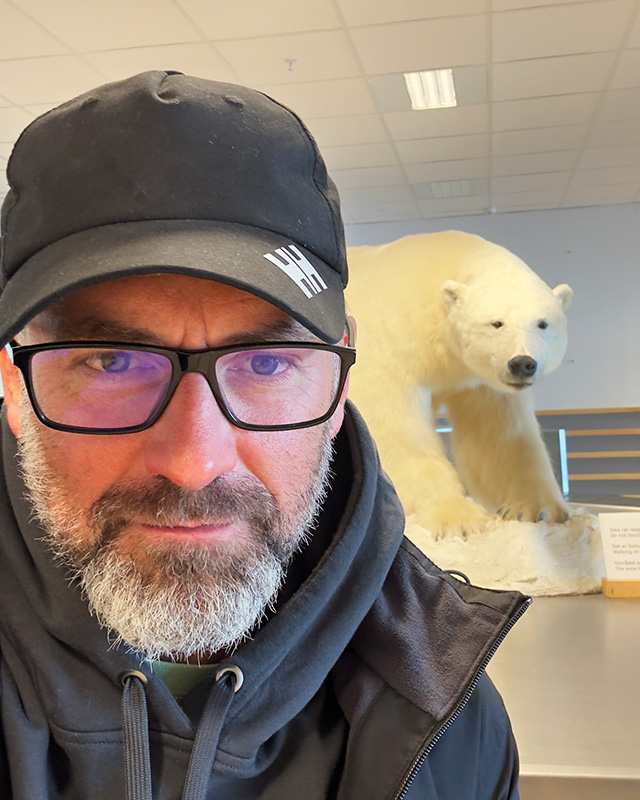Svalbard Expedition 2025
FIRST SVALBARD, THEN GREENLAND: THE JOURNEY BEGINS
A crucial 10-day Arctic training expedition at 80°N, building essential cold-weather experience and polar travel expertise before the Greenland crossing. Testing equipment, refining techniques, and gaining vital polar experience across Spitsbergen's challenging terrain. March 2025.
March 2024: First Steps on Arctic Ice
The Next Step: Svalbard 2025
At almost 80°N, Svalbard's Spitsbergen island provides the perfect Arctic training ground. This 10-day expedition in March 2025 serves as both essential preparation for my Greenland crossing and an intense immersion into polar expedition life.
Working with professional guides from Icetrek, I'll spend eight full days on the ice, hauling sleds through deep valleys, over glaciers, and across mountain passes. With temperatures potentially dropping to -35°C, this expedition offers vital experience in extreme cold-weather survival and polar travel techniques.
The journey includes:
- Intensive polar camping skills
- Navigation in Arctic conditions
- Glacier travel techniques
- Cold-weather equipment testing
- Sled hauling practice
- Essential polar survival skills
This isn't just about building technical skills - it's about understanding the rhythms of polar life, from managing equipment in extreme cold to maintaining energy through long days on the ice. Each challenge faced here lays crucial groundwork for the longer Greenland crossing ahead.
Expedition Context: This training expedition is part of my broader journey toward crossing Greenland in 2025. The skills, experience, and insights gained here will be essential for that larger challenge.
When and Where?
(exact dates may shift slightly due to weather and logistics).
March 2025 (11 days total):
- 2 days preparation in Longyearbyen
- 9 days on the ice
- Temperature range: potentially down to -35°C
Base: Longyearbyen, Spitsbergen, Svalbard (Norway)
- Located at 78°N
- One of the world's northernmost settlements
Starting from the outskirts of Longyearbyen, our exact route will be determined based on seasonal conditions. The journey will cover:
- Glacial terrain
- Mountain passes
- Deep valleys
- Frozen lakes

How Will It Happen?
- Cold weather camping systems
- Navigation techniques
- Equipment management
- Energy conservation
- Glacier travel skills
- Weather assessment
- Risk management
- Professional polar guides
- Established safety protocols
- Emergency communications
- Weather monitoring
- Daily route assessments
- Fine-tuning ski-hauling efficiency
- Advanced navigation practice
- Cold-weather systems optimization
- Glacier travel techniques
- Single-file travel formation
- Progressive increase in daily hours
- Practical navigation exercises
- Regular rotation of lead position
- Structured breaks for hydration and energy
- Early start to maximize daylight
- Stove operation and camp breakdown
- Water preparation for day ahead
- Sled packing and equipment checks
- Single-file travel formation
- Progressive increase in daily hours
- Practical navigation exercises
- Regular rotation of lead position
- Structured breaks for hydration and energy
- Camp setup in remaining daylight
- Polar bear protection systems
- Tent and equipment management
- Critical warmth maintenance
- Recovery and preparation for next day
- Camp setup in remaining daylight
- Polar bear protection systems
- Tent and equipment management
- Critical warmth maintenance
- Recovery and preparation for next day
Image Gallery
- Gerry van der Walt – Arctic Expedition – Mindset & Performance Coach
- Gerry van der Walt – Arctic Expedition – Mindset & Performance Coach
- Gerry van der Walt – Arctic Expedition – Mindset & Performance Coach
- Gerry van der Walt – Arctic Expedition – Mindset & Performance Coach
- Gerry van der Walt – Arctic Expedition – Mindset & Performance Coach
- Gerry van der Walt – Arctic Expedition – Mindset & Performance Coach
- Gerry van der Walt – Arctic Expedition – Mindset & Performance Coach
- Gerry van der Walt – Arctic Expedition – Mindset & Performance Coach
- Gerry van der Walt – Arctic Expedition – Mindset & Performance Coach
- Gerry van der Walt – Arctic Expedition – Mindset & Performance Coach
- Gerry van der Walt – Arctic Expedition – Mindset & Performance Coach
- Gerry van der Walt – Arctic Expedition – Mindset & Performance Coach
- Gerry van der Walt – Arctic Expedition – Mindset & Performance Coach
- Gerry van der Walt – Arctic Expedition – Mindset & Performance Coach
- Gerry van der Walt – Arctic Expedition – Mindset & Performance Coach
- Gerry van der Walt – Arctic Expedition – Mindset & Performance Coach
- Gerry van der Walt – Arctic Expedition – Mindset & Performance Coach
- Gerry van der Walt – Arctic Expedition – Mindset & Performance Coach
- Gerry van der Walt – Arctic Expedition – Mindset & Performance Coach
- Gerry van der Walt – Arctic Expedition – Mindset & Performance Coach
- Gerry van der Walt – Arctic Expedition – Mindset & Performance Coach
- Gerry van der Walt – Arctic Expedition – Mindset & Performance Coach
- Gerry van der Walt – Arctic Expedition – Mindset & Performance Coach
- Gerry van der Walt – Arctic Expedition – Mindset & Performance Coach
- Gerry van der Walt – Arctic Expedition – Mindset & Performance Coach
- Gerry van der Walt – Arctic Expedition – Mindset & Performance Coach
- Gerry van der Walt – Arctic Expedition – Mindset & Performance Coach
- Gerry van der Walt – Arctic Expedition – Mindset & Performance Coach
- Gerry van der Walt – Arctic Expedition – Mindset & Performance Coach
- Gerry van der Walt – Arctic Expedition – Mindset & Performance Coach
- Gerry van der Walt – Arctic Expedition – Mindset & Performance Coach
- Gerry van der Walt – Arctic Expedition – Mindset & Performance Coach
- Gerry van der Walt – Arctic Expedition – Mindset & Performance Coach
- Gerry van der Walt – Arctic Expedition – Mindset & Performance Coach
- Gerry van der Walt – Arctic Expedition – Mindset & Performance Coach
- Gerry van der Walt – Arctic Expedition – Mindset & Performance Coach
- Gerry van der Walt – Arctic Expedition – Mindset & Performance Coach
- Gerry van der Walt – Arctic Expedition – Mindset & Performance Coach
- Gerry van der Walt – Arctic Expedition – Mindset & Performance Coach
- Gerry van der Walt – Arctic Expedition – Mindset & Performance Coach
- Gerry van der Walt – Arctic Expedition – Mindset & Performance Coach
- Gerry van der Walt – Arctic Expedition – Mindset & Performance Coach
- Gerry van der Walt – Arctic Expedition – Mindset & Performance Coach
- Gerry van der Walt – Arctic Expedition – Mindset & Performance Coach
- Gerry van der Walt – Arctic Expedition – Mindset & Performance Coach
- Gerry van der Walt – Arctic Expedition – Mindset & Performance Coach
- Gerry van der Walt – Arctic Expedition – Mindset & Performance Coach
- Gerry van der Walt – Arctic Expedition – Mindset & Performance Coach
- Gerry van der Walt – Arctic Expedition – Mindset & Performance Coach
- Gerry van der Walt – Arctic Expedition – Mindset & Performance Coach
- Gerry van der Walt – Arctic Expedition – Mindset & Performance Coach
- Gerry van der Walt – Arctic Expedition – Mindset & Performance Coach
- Gerry van der Walt – Arctic Expedition – Mindset & Performance Coach
- Gerry van der Walt – Arctic Expedition – Mindset & Performance Coach
- Gerry van der Walt – Arctic Expedition – Mindset & Performance Coach
- Gerry van der Walt – Arctic Expedition – Mindset & Performance Coach
- Gerry van der Walt – Arctic Expedition – Mindset & Performance Coach
- Gerry van der Walt – Arctic Expedition – Mindset & Performance Coach
- Gerry van der Walt – Arctic Expedition – Mindset & Performance Coach
- Gerry van der Walt – Arctic Expedition – Mindset & Performance Coach
- Gerry van der Walt – Arctic Expedition – Mindset & Performance Coach
- Gerry van der Walt – Arctic Expedition – Mindset & Performance Coach
- Gerry van der Walt – Arctic Expedition – Mindset & Performance Coach
Arctic Partnership Opportunities 2025/26
Collaboration Opportunities
While this expedition is self-funded, I'm open to meaningful partnerships with brands and organizations who share my vision of pushing boundaries and inspiring achievement. Whether it's through:
- Clothing & Equipment testing and development
- Performance and endurance insights
- Content creation and storytelling
- Brand ambassador opportunities
- Expedition documentation
Beyond The Ice
These Arctic journeys connect directly to my work in:
- Mindset & Performance Coaching
- Curated Travel Experiences
- Corporate Speaking
- Adventure Guiding
- Mindset Development & Mentoring
Get Involved
If you're a brand, organization, or media outlet interested in collaboration opportunities across both the Svalbard and Greenland expeditions, let's discuss how we might work together.
















